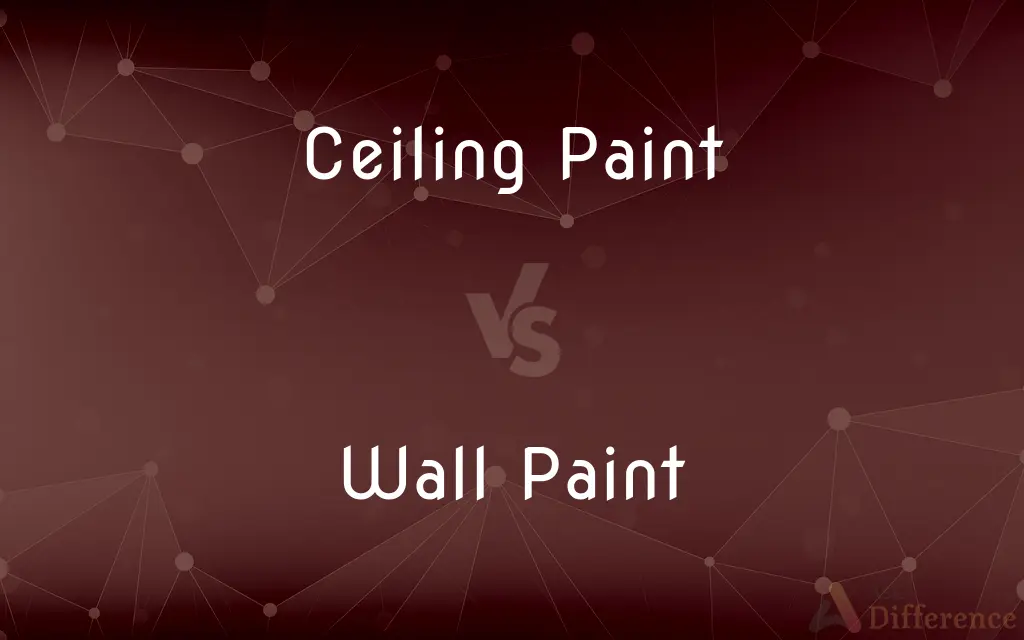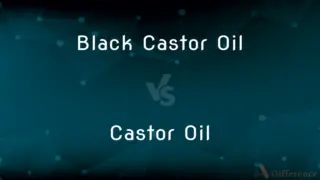Ceiling Paint vs. Wall Paint — What's the Difference?
Edited by Tayyaba Rehman — By Urooj Arif — Published on February 26, 2024
Ceiling paint is designed with a flat, matte finish to hide imperfections and reduce light glare, while wall paint comes in various finishes (e.g., matte, eggshell, satin) to withstand cleaning and touch-ups, offering more color choices.

Difference Between Ceiling Paint and Wall Paint
Table of Contents
ADVERTISEMENT
Key Differences
Ceiling paint is specifically formulated to achieve a flat or matte finish, which helps in minimizing the appearance of surface imperfections, such as bumps or small cracks. Its viscosity is adjusted to reduce drips and splatters during application, making the painting process smoother and cleaner. This type of paint is typically available in a limited color palette, predominantly white or off-white, to brighten rooms and create a perception of higher ceilings.
Wall paint, in contrast, is available in a wide range of finishes, including matte, eggshell, satin, semi-gloss, and gloss, each offering different levels of durability, sheen, and ease of cleaning. Wall paints are formulated to withstand frequent cleaning, touching up, and the wear and tear of daily life. They come in a vast array of colors, allowing for greater flexibility in interior design and personalization of spaces.
The choice between ceiling and wall paint is not just a matter of color or finish but also functionality. Ceiling paint's flat finish is excellent for hiding surface flaws but can be more challenging to clean. Wall paint's various sheens not only influence the aesthetic appeal but also affect the paint's durability and resistance to moisture, making higher sheen paints more suitable for kitchens, bathrooms, and high-traffic areas.
Applying the correct type of paint to ceilings and walls can significantly impact the overall look and feel of a room. Ceiling paint is best used for its intended purpose, to give ceilings a clean, uniform look without drawing attention away from the walls and decor. Wall paint, with its diversity in finish and color, is ideal for creating focal points, enhancing room dimensions, and reflecting personal style.
Choosing the right paint involves considering the room's function, lighting, and desired ambiance. While ceiling paint is a practical choice for most ceilings, wall paint provides the versatility needed to achieve various design objectives, from creating a cozy, intimate space with matte finishes to adding vibrancy and depth with bolder colors.
ADVERTISEMENT
Comparison Chart
Finish
Flat/Matte
Matte, Eggshell, Satin, Semi-Gloss, Gloss
Purpose
Hide imperfections, reduce glare
Durability, easy cleaning, aesthetic choice
Viscosity
Thicker to reduce drips
Varies with finish type
Color Availability
Limited (mostly whites)
Wide range of colors
Cleaning and Maintenance
More difficult to clean
Easier to clean, especially higher sheens
Application Area
Ceilings
Walls
Durability
Less concern for durability
Formulated for higher durability
Light Reflection
Minimized to avoid highlighting flaws
Varies, higher sheens reflect more light
Usage
Primarily residential ceilings
Residential and commercial walls
Sheen Options
None
Multiple options for aesthetic and functional needs
Compare with Definitions
Ceiling Paint
Less suitable for areas requiring frequent cleaning.
They avoided using ceiling paint in the kitchen due to its harder-to-clean surface.
Wall Paint
Suitable for both aesthetic appeal and practicality.
Selecting eggshell wall paint balanced the need for low glare with cleanability.
Ceiling Paint
Predominantly available in white to brighten rooms.
The white ceiling paint made the small room feel more spacious and airy.
Wall Paint
Used to create focal points and enhance room dimensions.
Dark wall paint on one wall created a stunning accent in the dining area.
Ceiling Paint
Offers a uniform look without drawing attention.
The ceiling's flat finish blended perfectly, keeping the focus on the colorful walls.
Wall Paint
Higher sheen options are easier to clean and maintain.
The semi-gloss wall paint in the hallway easily wiped clean from scuffs.
Ceiling Paint
Specially formulated for ceilings with a flat finish to hide imperfections.
He chose ceiling paint for its matte finish, making the living room ceiling appear flawless.
Wall Paint
Available in a variety of finishes for different needs.
She chose a satin wall paint for its durability and slight sheen.
Ceiling Paint
Designed to minimize drips for a cleaner application.
Applying ceiling paint was less messy, thanks to its thicker consistency.
Wall Paint
Comes in an extensive color palette for design flexibility.
The vibrant wall paint added a lively splash of color to the room.
Common Curiosities
Why is ceiling paint usually white?
White ceiling paint helps reflect light, making spaces appear brighter and ceilings higher, contributing to a more spacious feeling room.
What sheen is best for high-traffic areas?
Semi-gloss or gloss finishes are best for high-traffic areas due to their durability and ease of cleaning.
How do I choose between the different finishes of wall paint?
Consider the room's function, the desired ambiance, and maintenance needs. Matte or eggshell finishes work well in low-traffic areas, while satin, semi-gloss, or gloss are better for areas that require frequent cleaning.
Is there a performance difference between ceiling and wall paints?
Yes, ceiling paint is optimized for hiding imperfections and minimal light reflection, while wall paint is formulated for durability, ease of cleaning, and aesthetic variety.
Can ceiling paint help with room acoustics?
The flat finish of ceiling paint can slightly absorb sound, but specialized acoustic paints are better suited for significant acoustic improvements.
Can I use wall paint on the ceiling?
While you can use wall paint on the ceiling, it may not hide imperfections as well as ceiling paint and could be more prone to dripping during application.
Can I clean ceiling paint?
Yes, but it may be more challenging than cleaning wall paint, especially if the ceiling paint has a very flat finish.
How often should I repaint my ceiling compared to my walls?
Ceilings generally require repainting less frequently than walls due to lower exposure to wear and tear, unless there's smoke, water damage, or similar issues.
How many coats of paint do I need for the ceiling?
It often depends on the paint quality and the ceiling's current color. Typically, one to two coats are required, but a primer coat might be necessary for better coverage.
Is it necessary to paint the ceiling before the walls?
Painting the ceiling first is generally recommended to avoid splatters on freshly painted walls. It allows for easier cleanup and a more professional finish.
Does the thickness of ceiling paint affect its application?
Yes, the thicker viscosity of ceiling paint helps reduce drips and splatters, making it easier to apply overhead.
Can I use ceiling paint in a bathroom?
Yes, but ensure the ceiling paint is suitable for high moisture environments. Some ceiling paints are specifically formulated to resist mold and mildew.
Are there eco-friendly options for ceiling and wall paints?
Yes, there are low-VOC (volatile organic compounds) and zero-VOC paints available for both ceilings and walls, offering eco-friendly and healthier indoor air quality options.
Does ceiling paint require a primer?
While some ceiling paints are designed to be used without a primer, applying a primer can improve adhesion and coverage, especially on new drywall or when covering dark colors.
How do I choose the right color for my ceiling paint?
Consider the room's height and lighting. Light colors can make a room feel larger and brighter, while dark colors can create a cozy, intimate feel but may make the space appear smaller.
Can I mix ceiling paint with wall paint to create a custom finish?
Mixing ceiling and wall paint is not recommended, as they are formulated differently and mixing could affect the finish, durability, and application properties.
Can glossy finishes be used on ceilings?
Glossy finishes can be used on ceilings for specific design effects, such as reflecting more light in a dark room, but they may highlight imperfections more than flat finishes.
What's the best way to touch up ceiling paint?
For best results, use the original paint applied to the ceiling. Apply touch-ups sparingly with a small brush or roller, blending into the surrounding area to minimize visibility.
What type of roller should I use for ceiling paint?
Use a roller with a thick nap (around 3/8 to 1/2 inch) for textured ceilings and a smoother nap for flat ceilings. The thicker nap helps apply paint evenly over textures.
Why does my ceiling paint look patchy?
Patchy appearance can result from uneven application, insufficient drying time between coats, or not using a primer when needed. Ensure even coverage and allow proper drying time for the best results.
Share Your Discovery

Previous Comparison
Black Castor Oil vs. Castor Oil
Next Comparison
Psychologically vs. PhysiologicallyAuthor Spotlight
Written by
Urooj ArifUrooj is a skilled content writer at Ask Difference, known for her exceptional ability to simplify complex topics into engaging and informative content. With a passion for research and a flair for clear, concise writing, she consistently delivers articles that resonate with our diverse audience.
Edited by
Tayyaba RehmanTayyaba Rehman is a distinguished writer, currently serving as a primary contributor to askdifference.com. As a researcher in semantics and etymology, Tayyaba's passion for the complexity of languages and their distinctions has found a perfect home on the platform. Tayyaba delves into the intricacies of language, distinguishing between commonly confused words and phrases, thereby providing clarity for readers worldwide.
















































